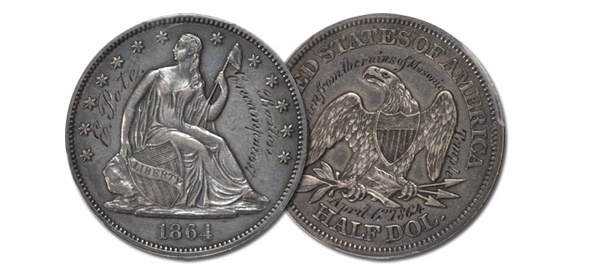
By Greg Cohen and John Pack – Stacks Bowers Auctions ……….
Traditionally, the New York Americana Sale features important collections of American federally issued and colonial era coins, alongside a very strong selection of Numismatic Americana (what used to be called “Exonumia”) — a catch all for medals, tokens, and similar numismatic items that do not fit into a Guide Book of United States Coins (or Red Book) category. This diversity of offerings has made the Americana Sale a focal point on our auction calendar every year. The 2015 Americana Sale is no different, and this week we are offering a sneak peak at a rare and interesting Boston Masonic Temple half dollar from 1864.
The description penned by John Pack, with the assistance of John Kraljevich, tells the whole story of this intriguing and rare piece, and the description is quoted below in its entirety:
1864 Boston Masonic Lodge Half Dollar. Rulau Ma-Bo 51, Brunk-26400, page 221. Inscribed to E. Pote. AU-50 (PCGS). Deep steel gray with accents of blue in the fields and lighter gray on the high points of the relief. Hand-engraved with great skill in the obverse fields to “E. Pote” at left, and with “Boston Encampment” at right. The reverse is similarly engraved around the central device, “Taken from the ruins of Masonic / Temple / April 6th, 1864.” These very rare Masonic half dollars were little understood and usually traded as “love tokens” or similar until a fine article by collector and dealer Mark Hotz was published on them in the February 1993 edition of The Numismatist and shed important light on them. The rarity of these coins is such that most collectors have never seen one and are largely unaware of their historic nature. The Boston Masonic Temple, known at the time as the Winthrop House (named for the distinguished old Boston family), was destroyed by fire in April 1864. Due to the engraving on the coins, it has long been accepted that the fire was April 6th, though the 1866 By-Laws of St. Andrews Royal Arch Chapter at Boston gives the date of the fire as April 5th. It is likely that the actual recovery of the silver was the following day, as stated on the coin. It was a six-story structure built in 1845 at the corner of Boylston and Tremont streets at the southeast corner of the famed Boston Common.
The following is, with permission, reproduced from a description of another such piece written by John Kraljevich, and published on his website, jkamericana.com:
“The fire burned hot and long, and news of it was a story nationwide. Though many priceless artifacts were lost forever, the Temple’s leadership was able to salvage the ceremonial silver implements, which they then sent to the Philadelphia Mint and had turned into a specially-struck batch of half dollars. The half dollars were engraved appropriately, with the reverses inscribed ‘Taken from the ruins of Masonic Temple / April 6, 1864,’ and sold for $1 each as fundraisers. This, in and of itself, was noteworthy: due to the Civil War, specie payments were suspended, and new silver coins were simply not seen in circulation in the East. Money was scarce in general, and few of these commemorative relic half dollars were issued. By 1871, the specially struck commemorative half dollars for the Boston Masonic Temple were already well known enough to be covered in the American Journal of Numismatics…When Hotz wrote, just two were identified. Since then, a few more have been published, with most estimates of those known focused around a half dozen total pieces.”
There are six different pieces listed in Russell Rulau’s Standard Catalogue of United States Tokens, including the one sold by Kraljevich earlier this year. The one offered presently is not among them. It has been suggested that the engraving was done at the Mint, as it is finely accomplished and largely uniform in layout. However, this seems highly unlikely as the engraving of coins as mementos was generally the realm of jewelers, while the production of coinage was the sole business of the Mint. One of the pieces illustrated by Rulau has a differently styled engraving, lending some evidence that more than one party may have been involved. This suggests that the engravings were likely contracted privately, probably in Boston, where the pieces were sold and where there would have been no shortage of skilled engravers and silversmiths ready to accept such a project. The fact that the personal inscription phraseology differs between coins, and some have no name at all suggests that those who ordered them had some say in how the engravings were completed. This one is engraved to E. Pote, perhaps Elisha Pote. There is little published about him beyond his mention in the 1874 Proceedings of the Grand Commandery of Knights Templars and the Appendant Orders of Massachusetts and Rhode Island.
The Americana Sale will be posted to the website, at www.stacksbowers.com shortly and you will be able to view and bid on this coin, as well as the many other wonderful rarities that will be crossing the auction block in New York on February 5 and 6. To request a catalog, contact one of our auction services associates. If, like our consignor, you have rare and interesting coins, banknotes, or numismatic Americana you are interested in selling, contact one of our consignment directors.




